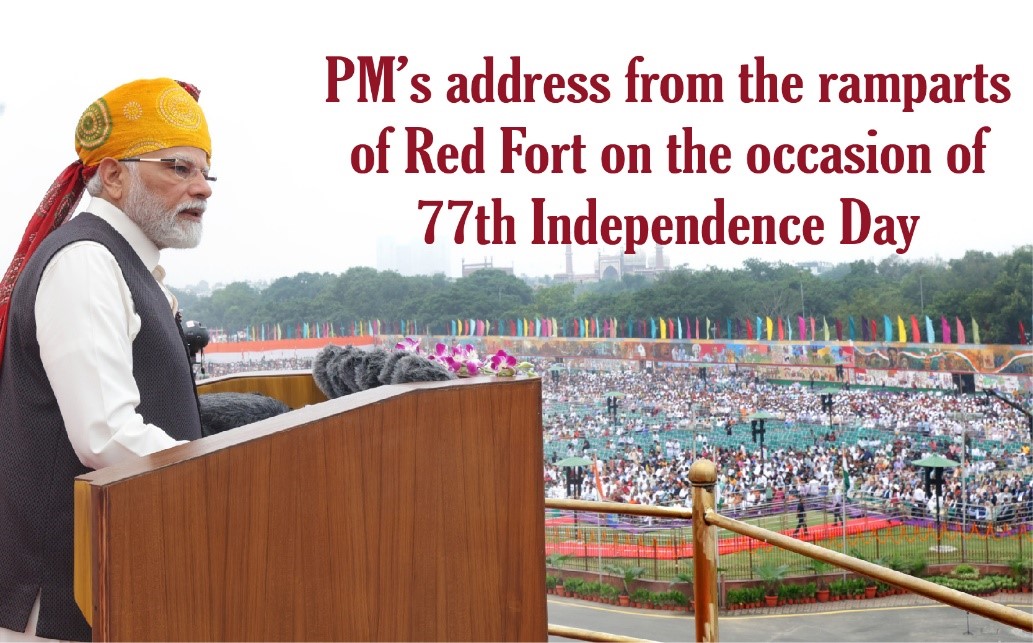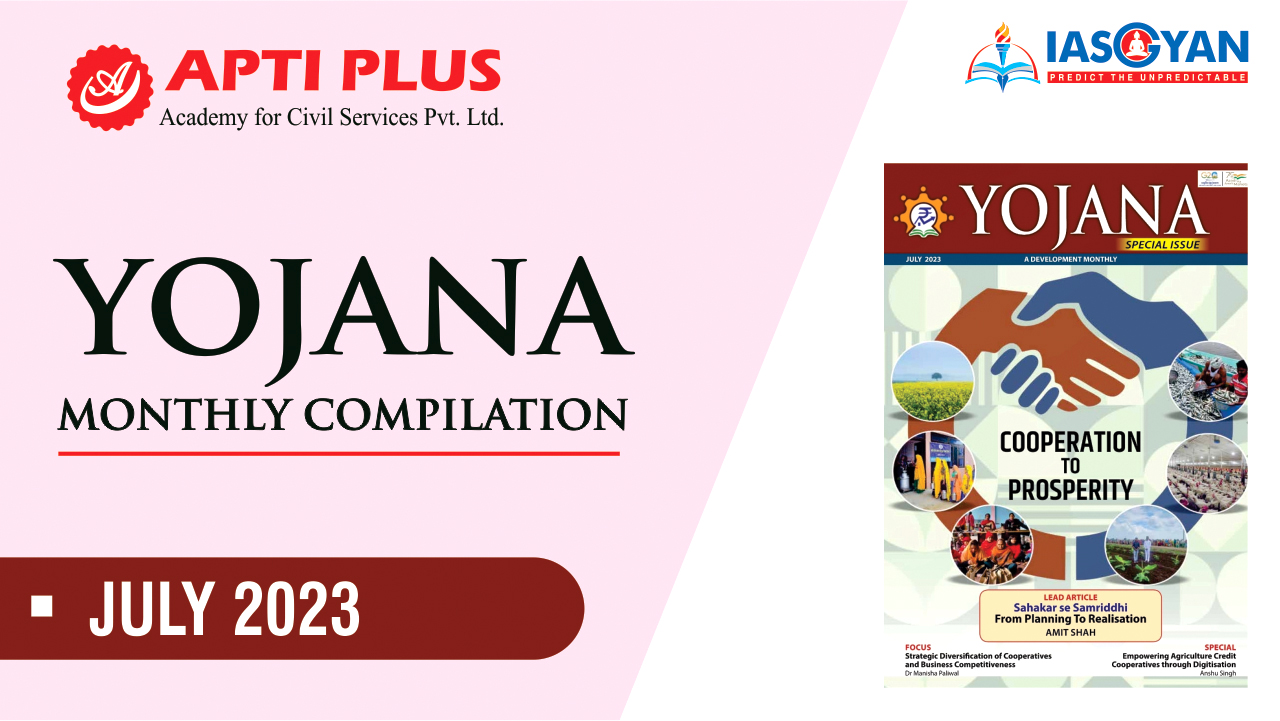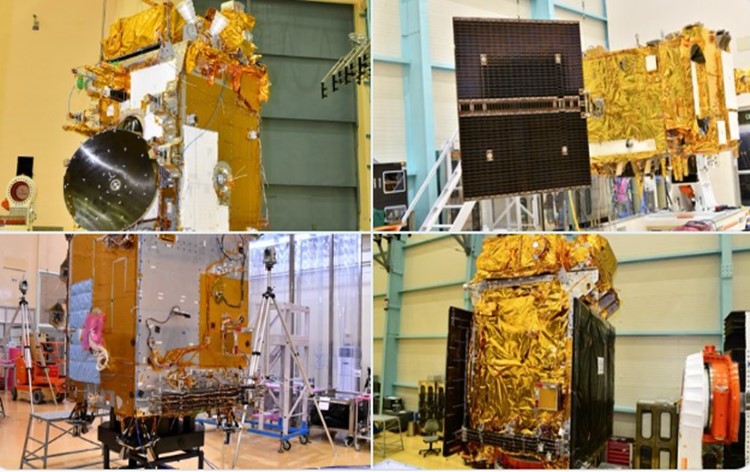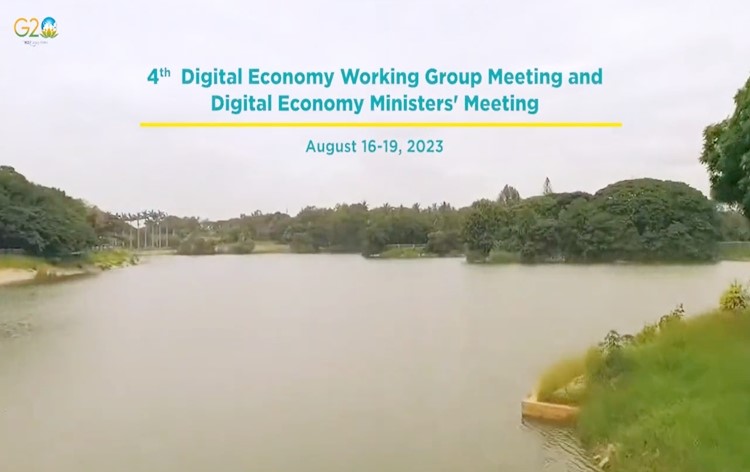SPOTLIGHT| Prime Minister's Address to The Nation on the Occasion of 77th Independence Day

Disclaimer: Copyright infringement not intended.
Context
- Prime Minister Shri Narendra Modi, addressing the nation on the occasion of 77th Independence Day from the ramparts of historic Red Fort in New Delhi.
Key Details
- Addressing the nation from the ramparts of Red Fort on 77th Independence Day on 15th August 2023, Mr Modi said, India has an opportunity during this first year of Amrit Kaal to dedicate lives and work towards scripting the next 1000 years.
- He said India's rise and development resulted in renewed global confidence in the country.
- The Prime Minister said India's progress is not only fuelled by big cities like Delhi, Mumbai and Chennai. He said the youth of tier-2 cities are also creating an equal impact on the progress of the nation.
- Modi told the youth that there is no dearth of opportunities and the country is ready to give them as many opportunities as they want.
- The Prime Minister remembered and bowed down to all the people who have contributed and sacrificed in the freedom struggle of the country.
- He said, today on 15th August, the nation is celebrating the 150th birth anniversary of revolutionary leader Sri Aurobindo.
- Mr Modi said the 150th birth anniversary of Swami Dayanand Saraswati, the 500th birth anniversary of Rani Durgavati and the 525th anniversary of Bhakti movement icon Meerabai is also this year.
- He said, 140 crore family members - the world's biggest democracy and now the world's biggest in terms of population - are celebrating the festival of freedom today.
About Key highlights of the speech
- Launch of the 'Vishwakarma scheme' to support traditional skills and crafts with an allocation of Rs 13,000 to 15,000 crore.
- Praise for women's achievements in Science, technology, engineering, and mathematics (STEM) fields and the role of women in India's progress. He also announced that women will be able to join the National Defence Academy (NDA) and be eligible for permanent commission in the armed forces.
- India's role as a leader in the global south and its contributions to global stability. He said that India has extended its support to over 150 countries during the Covid-19 pandemic and has also taken initiatives such as the International Solar Alliance (ISA) and the Coalition for Disaster Resilient Infrastructure (CDRI).
- India's significance in the changing geopolitical landscape. He said that India has shown its resolve to protect its sovereignty and interests in the face of external threats and challenges. He also said that India is committed to maintaining peace and harmony in its neighborhood and beyond.
- The emphasis on a strong government committed to the nation's interests. He said that his government has taken bold decisions such as abrogating Article 370, implementing GST, banning triple talaq, enacting farm laws, and carrying out surgical strikes.
- India's progress extends beyond major cities to Tier-2 and Tier-3 cities. He said that his government has launched schemes such as Smart Cities Mission, AMRUT, PM Awas Yojana, PM Gram Sadak Yojana, etc. to ensure urban and rural development.
- Efforts to control inflation and take steps to ease inflation pressures. He said that his government has taken measures such as increasing MSPs, providing free ration, expanding PM Kisan Samman Nidhi, etc. to help farmers and consumers.
- The focus is on regional development and ensuring that every part of India thrives. He said that his government has given special attention to regions such as Northeast, Jammu & Kashmir, Ladakh, Andaman & Nicobar Islands, etc. to ensure their development and integration.
About the schemes
- Around 1,800 people from different vocations, with their spouses, were invited from across the country to be a part of the celebrations at Red Fort as Special Guests.
- These Special Guests include over 400 Sarpanches of more than 660 vibrant villages, 250 from Farmer Producer Organisations scheme, 50 participants each of Pradhan Mantri Kisan Samman Nidhi Scheme and Pradhan Mantri Kaushal Vikas Yojana, 50 Shram Yogis construction workers of the Central Vista Project, including the New Parliament Building, 50 workers involved in the construction of border roads, making of Amrit Sarovar and Har Ghar Jal Yojana as well as 50 each primary school teachers, nurses, and fishermen.
Amrit Bharat Station Scheme:
- The ABSS involves improvement of amenities at the stations like entry and exit, circulating areas, waiting halls, toilets, lift/escalators, cleanliness, free Wi-Fi, kiosks for local products through schemes like ‘One Station One Product’, better passenger information systems, Executive Lounges, nominated spaces for business meetings, landscaping, etc.
Vishwakarma scheme:
- The PM Vishwakarma Scheme aims to improve the quality, scale and reach of products and services of artisans and craftspeople and to integrate them with the domestic and global value
- This would result in the economic empowerment of such workers, especially those belonging to the Scheduled Castes, Scheduled Tribes, Other Backward Communities, women, transgender and other weaker sections of the society.
One Rank One Pension scheme:
- One Rank One Pension (OROP), or "same pension, for the same rank, for the same length of service, irrespective of the date of retirement".
- In 1973, the Government terminated 'One Rank One Pension' as the basis for deciding the pension of Indian Armed Forces Personnel through an administrative order.
- In addition, the Government, based on the report of the third Pay Commission, from which Armed Forces representation was excluded, and which was dominated by bureaucrats, increased the pension of civilians, who retired at 58, from 30 to 50%, a net increase of 20%; and reduced the pension of soldier, with the caveat that for full pension the minimum service was 33 years.
- Before OROP, ex-servicemen used to get pensions as per the Pay Commission's recommendations at the time when they had retired.
- The implementation of the OROP was based on the recommendation of the Koshiyari committee, a 10-member all-party parliamentary panel formed under the chairmanship of Bhagat Singh Koshiyari.
Vibrant Villages’ scheme:
- It is a centrally-sponsored scheme under which holistic developmental works are to be undertaken in northern bordering villages and with an outlay of ₹4,800 crores.
- Out of the financial allocation of 4800 Crore 2500 crore rupees will be used for roads.
- In the first phase, the programme will cover 662 villages, where job opportunities will be created to curb migration of the local population and sustainable economic activities will be encouraged.
- The program aims to;
- Improve infrastructure in border villages along India’s border with China.
- Improve infrastructure in Uttarakhand, Himachal Pradesh, and Arunachal Pradesh.
- To construct residential and tourist centers.
- Improve road connectivity.
- Develop decentralized renewable energy sources.
- Provide direct access to Doordarshan, education-related channels, and broadband connections.
- Create employment and livelihood opportunities
- Reduce poverty and ensure socio-economic development.
Closing thoughts
- The Prime Minister's speech was received with applause and enthusiasm by the people of India who celebrated their Independence Day with pride and patriotism. The speech also reflected India's confidence and optimism as it faces the challenges of the present and prepares for the future.
https://newsonair.gov.in/News?title=PM-Modi-addresses-nation-on-77th-Independence-Day&id=466128#:~:text=Addressing%20the%20nation%20from%20the,scripting%20the%20next%201000%20years.
https://www.livemint.com/news/india/pm-modi-announces-vishwakarma-scheme-allocates-rs-13-000-cr-15-000-cr-for-those-with-traditional-skills-details-here-11692067668533.html
https://indianexpress.com/article/india/prime-minister-narendra-modi-independence-day-speech-2023-full-text-8893141/

India’s first solar mission
Context
- Indian Space Research Organisation is planning its next launch of the Aditya L1 satellite this month.
Details
- It will be the first space-based Indian mission to study the Sun.
- The satellite will carry seven instruments to study the solar atmosphere, solar magnetic storms and their impact on the environment around Earth.
- It will be ed in a halo orbit around the L1 point between the Earth and the Sun.
- The satellite will take around 109 Earth days after launch to reach the halo orbit called L1, covering a distance of over 1.5 million kilometers.

Disclaimer: Copyright infringement is not intended
About Aditya L1 satellite
- The Aditya-L1 mission, developed by the Indian Space Research Organisation (ISRO), represents India's first space-based observatory dedicated to studying the Sun.
- Positioned at the Lagrange point 1 (L1), located about 1.5 million km from Earth, this pioneering mission aims to unravel the mysteries of the Sun's behavior, magnetic fields, and space weather impacts.
|
About the Sun
The Sun, a colossal ball of hot, glowing plasma, serves as the center of our solar system and is the primary source of light, heat, and energy that sustains life on Earth.
Its immense size and intense energy production have fascinated astronomers and scientists for centuries.
|
https://newsonair.gov.in/News?title=ISRO-plans-to-launch-India%e2%80%99s-first-solar-mission%2c-Aditya-L1-satellite-in-August&id=466192
.jpg)
G20 Digital Economy Working Group
Context
- The G20 Digital Economy Working Group meeting was formally opened by Alkesh Kumar Sharma, the Secretary of the Ministry of Electronics and Information Technology in Bengaluru today.

Disclaimer: Copyright infringement is not intended
Details
- Addressing the delegates, he informed that a 17-page precise and concise document is prepared after thorough consultations and consensus on the digital economy, cyber security, digital skilling and supporting lower and middle Economies in digital transactions and skilling.
- The fourth meeting being held in Bengaluru now, he added, will iron out whatever little differences and present the final document for signing during the ministerial meeting.
About the G20 Working Group Meeting and Digital Economy
- The G20 Working Group meeting and Digital Economy Ministerial meetings in Bengaluru is up to August 19.
- During the deliberations under the G20 India Presidency, various issues relating to digital information, service delivery to citizens and growth of the digital economy will be discussed.
- Running parallel to these meetings will be the Digital Innovation Alliance summit on August 17 and 18th.
- This will be an effort to 'recognise and support innovators from various G20 member countries and Guest countries.
- After the Digital Economy Ministerial Meeting, a joint statement on the outcome that will summarise the agreement on the challenges and opportunities of digital economies will be issued.
https://newsonair.gov.in/News?title=G20-Digital-Economy-Working-Group-meeting-begins-in-Bengaluru&id=466182

Parsi New Year Navroz
Context
- Parsi community is celebrating New Year i.e. Navroz today. Community members are visiting agiaries and offer prayers with friends and family members.
Details
- Akashvani correspondent reports, in Persian 'Nav' stands for 'new' while 'Roz' means 'day' which translates to 'new day'.
- Mumbai has a sizable population of Parsi community and many agiaries. Parsi community members have been offering prayers in these agiaries since morning.
- Their houses are decorated with rangoli and flowers. Many Parsi homes have prepared traditional delicacies like ravo and superfine along with others.
About the festival:
- Novruz begins on the first day of the Farvardin, the first month of the Iranian solar calendar at the spring equinox, and continues for 12 days.
Origins of Novruz
- The origins of the festival are unclear.
- While for the Kurds, Novruz stands as a symbol of resistance, for Persians, it is purely a cultural festival.
- For Persians, it is a “reminder of values that bind all people together with the aim of mutual understanding, unity, and peace,” Khalid states.
- These days, the festival, in both nations, stands as a "symbol of national identity" and as a tourism resource.
Parsi Community in India
- Following religious persecution in Iran, Parsis arrived in India in 936 AC and sought refuge under the Hindu King of Gujarat, Jadav Rana.
- They continued to preserve their culture and religious identity in India, as they built the first fire temple, Atash Behram, to shelter their holy fire which they had rescued from Iran.
- The sacred fire is now located in a temple in Udvada, Gujarat, which has become the heart of the Parsi culture in India.
- Surat had become a major trade center for the community by the 16th century.
- As a large part of this community included weavers and artisans the British willingly conducted businesses in the country through the community.
- In the present times, about 70 percent of Parsis are concentrated in Mumbai and are intimately connected to the city.
https://newsonair.gov.in/News?title=Parsi-New-Year-Navroz-being-celebrated-today&id=466184

Diplomatic Relations on Independence Day
Context
- The 77th Independence Day of India was celebrated with fervor and enthusiasm at the Embassy of India in Riyadh, Saudi Arabia’s capital.
Details
- The event brought together more than 500 individuals, including members of the Indian community, friends of India, journalists, and Indian Embassy officials.
- In Saudi Arabia, the Indian Embassy has organized a series of remarkable events under the framework of ‘Azadi Ka Amrit Mahotsav’, including cultural events, film festivals, a golf tournament, distinguished speaker series, yoga events and multiple exhibitions.
- This celebration aligns with the 75th anniversary of the diplomatic relationship between India and Saudi Arabia.
India and Saudi Arabia: Towards A Bright Future:
- Based on the edifice and a strong foundation of historic and cultural ties built over the centuries, India and Saudi Arabia have been able to grow a stronger multifaceted relationship over the decades after their independence.
- The trajectory of growth of their bilateral ties suggests that India and Saudi Arabia have a promising and bright future together, given their pace of cooperation and engagement.
- While the Indian government is keen to seek Foreign Direct Investment to foster its economic growth and that it facilitates FDI by easing restrictions, India can serve as a bigger market for oil exports for Saudi Arabia as its economy grows, thereby creating more demand for oil.
- The future of bilateral trade between countries holds tremendous potential for mutual benefit.
- Thus, a strong strategic partnership and frequent engagement between the ministries and officials of India and Saudi Arabia will build strong mutual trust that will inevitably translate into economic growth.
https://newsonair.gov.in/News?title=India-and-Saudi-Arabia-Commemorate-75-Years-of-Diplomatic-Relations-on-Independence-Day&id=466153






